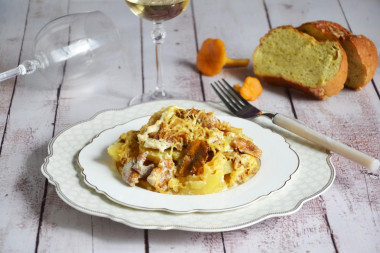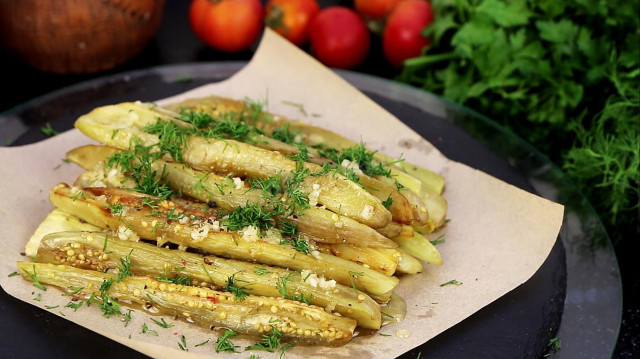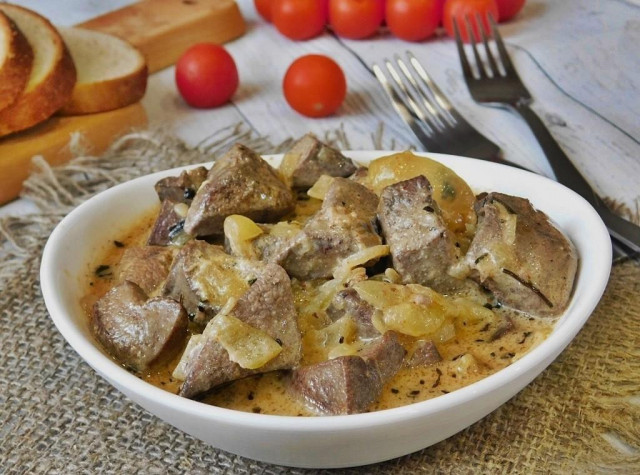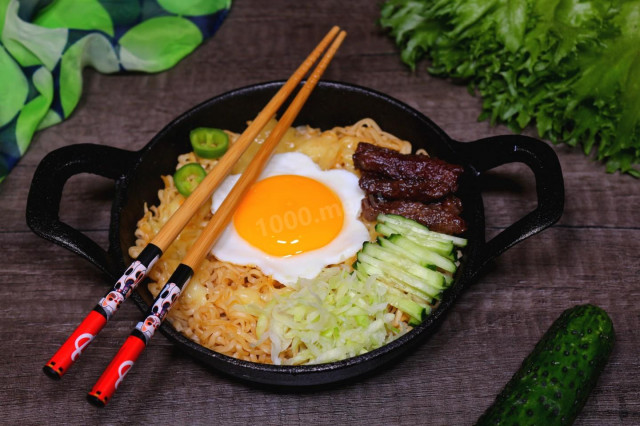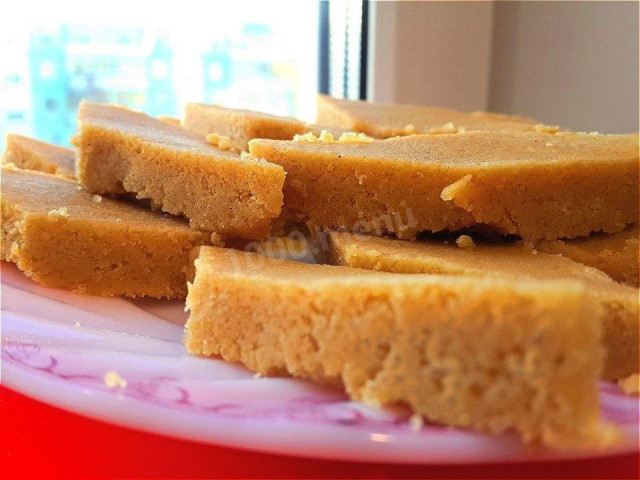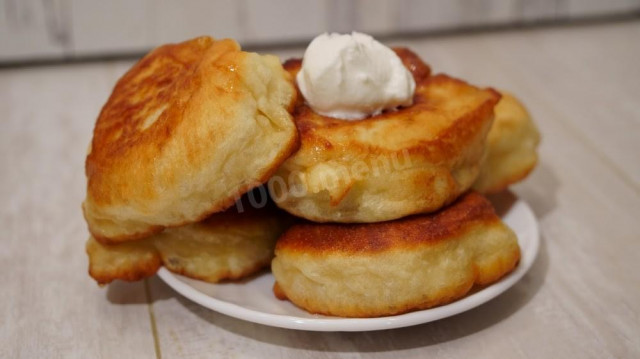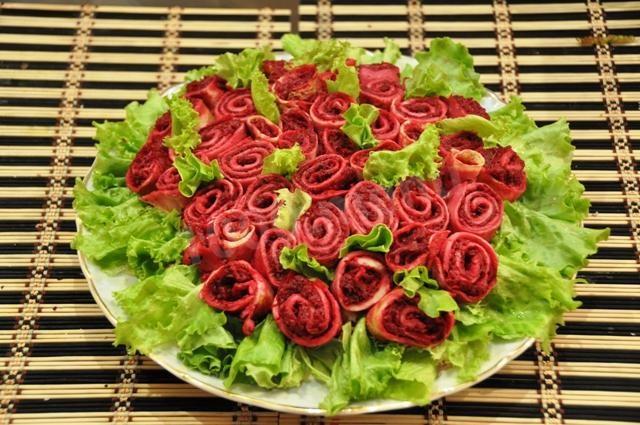Composition / ingredients
Step-by-step cooking
Step 1:
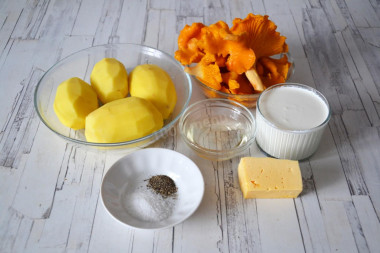
Prepare the ingredients. To cook potatoes with chanterelles in the oven, we will need: potatoes; chanterelle mushrooms; cream (20% fat content); cheese; vegetable oil; ground black pepper and salt.
Step 2:
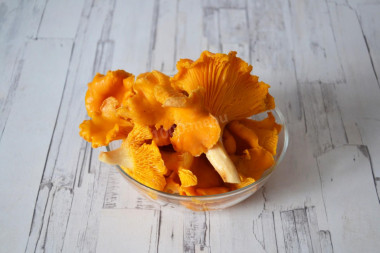
Wash and dry the chanterelles thoroughly.
Step 3:

Heat vegetable oil in a frying pan and fry chanterelles on it until excess moisture evaporates.
Step 4:

Wash the potatoes, peel and cut into not very thick circles.
Step 5:
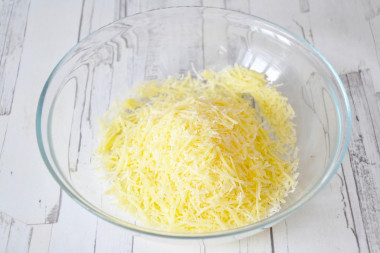
Grate cheese on a coarse grater.
Step 6:
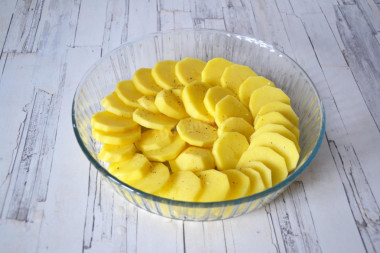
In the baking dish, put the potato slices overlap. Season the potatoes with salt and pepper.
Step 7:

Spread the fried chanterelles evenly on top.
Step 8:
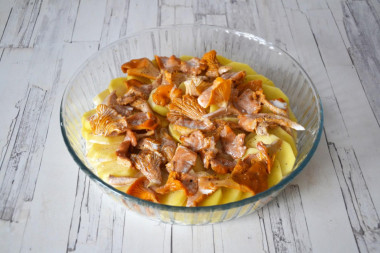
Pour in the cream. Season the mushrooms with salt and pepper. It is not necessary to salt too much, since the cheese on top is also salty.
Step 9:

Sprinkle everything with grated cheese on top.
Step 10:

Cover the mold with foil and put it in a preheated 180 ° C oven for 50 minutes.
Step 11:
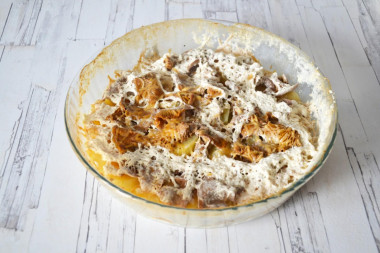
Then remove the foil and bake the potatoes with mushrooms for about 20 minutes, until the cheese is browned.
Step 12:

Serve potatoes with chanterelles hot. Enjoy your meal!
Useful properties of chanterelles are due to their chemical composition, because they contain substances such as: chitinmannose; phytosterols (ergosterol); trametonolic acid; acetylene fatty acids; vitamins (D, C, group B, beta-carotene); niacin; mineral elements; purines. And now let's figure it out in order.
These mushrooms are interesting for the presence of a unique substance - chitinmannose, which kills parasites. This polysaccharide literally dissolves the eggs of worms, and also paralyzes their nerve receptors. At the same time, this substance acts selectively and does not cause any harm to a person. No one has ever met wormy chanterelles, thanks to chitinmannosis, parasites of all stripes avoid meetings with the fungus.
100 g of chanterelles is more than the daily norm of vitamin D, without which the growth and development of bone tissue, blood clotting is impossible. With the help of this vitamin, calcium is deposited in the bones and dentin. It is unusual in that it acts both as a hormone and as a vitamin. Deficiency of this substance in the body repeatedly increases the risk of heart, cancer and skin diseases. Vitamin D increases immunity, strengthens muscles, normalizes blood pressure and thyroid activity. It also suppresses the growth of cancer cells, which is used in the prevention and treatment of cancer as an auxiliary.
Vitamin B6, pyridoxine, provides the production of serotonin, protein, hemoglobin and histamine. It lowers cholesterol in the blood, promotes the absorption of fats and has a positive effect on the heart rate. The body needs this vitamin for the normal functioning of the nervous system and liver.
Pyridoxine prevents the occurrence of skin diseases.
Chanterelles are rich in vitamin C, which increases immunity. This substance not only has a positive effect on the body's resistance to infections, but also participates in carbohydrate metabolism and collagen synthesis. Vitamin C is involved in blood clotting, so these mushrooms are useful for various bleeding. Ascorbic acid is necessary for the removal of toxins from the body. Its deficiency in the tissues of bones and teeth can lead to their destruction.
Niacin is the most important participant in metabolism, helping the stomach and intestines to break down and digest food. It is necessary to reduce cholesterol levels and joint mobility. This substance dilates small vessels, has a calming effect and is used in the treatment of migraines, anxiety, depression and distraction.
These yellow mushrooms contain a lot of folic acid, vitamin B9, which is involved in hematopoiesis and is responsible for the production of red blood cells. The lack of this acid in the body leads to anemia. This vitamin promotes cell regeneration, as well as their development. In addition, this substance improves digestion and increases appetite.
Pantothenic acid, vitamin B5, participates in metabolism, stimulates the production of glucocorticoids, anti-inflammatory and anti-allergic hormones by the adrenal glands. With a deficiency of this vitamin, the body's resistance to infections decreases.
Caloric content of the products possible in the composition of the dish
- Ripe potatoes - 80 kcal/100g
- Baked potatoes - 70 kcal/100g
- Mashed potatoes - 380 kcal/100g
- Boiled potatoes - 82 kcal/100g
- Potatoes in uniform - 74 kcal/100g
- Fried potatoes - 192 kcal/100g
- Buttermilk - 36 kcal/100g
- Cream of 20 % fat content - 300 kcal/100g
- Cream of 10% fat content - 120 kcal/100g
- Cream - 300 kcal/100g
- Chanterelles - 13 kcal/100g
- Dutch cheese - 352 kcal/100g
- Swiss cheese - 335 kcal/100g
- Russian cheese - 366 kcal/100g
- Kostroma cheese - 345 kcal/100g
- Yaroslavsky cheese - 361 kcal/100g
- Altai cheese 50% fat content - 356 kcal/100g
- Soviet cheese - 400 kcal/100g
- Cheese "steppe" - 362 kcal/100g
- Uglich cheese - 347 kcal/100g
- Poshekhonsky cheese - 350 kcal/100g
- Lambert cheese - 377 kcal/100g
- Appnzeller cheese with 50% fat content - 400 kcal/100g
- Chester cheese with 50% fat content - 363 kcal/100g
- Edamer cheese with 40% fat content - 340 kcal/100g
- Cheese with mushrooms of 50% fat content - 395 kcal/100g
- Emmental cheese with 45% fat content - 420 kcal/100g
- Gouda cheese with 45% fat content - 356 kcal/100g
- Aiadeus cheese - 364 kcal/100g
- Dom blanc cheese (semi-hard) - 360 kcal/100g
- Lo spalmino cheese - 61 kcal/100g
- Cheese "etorki" (sheep, hard) - 401 kcal/100g
- White cheese - 100 kcal/100g
- Fat yellow cheese - 260 kcal/100g
- Altai cheese - 355 kcal/100g
- Kaunas cheese - 355 kcal/100g
- Latvian cheese - 316 kcal/100g
- Limburger cheese - 327 kcal/100g
- Lithuanian cheese - 250 kcal/100g
- Lake cheese - 350 kcal/100g
- Gruyere cheese - 396 kcal/100g
- Ground black pepper - 255 kcal/100g
- Vegetable oil - 873 kcal/100g
- Salt - 0 kcal/100g


